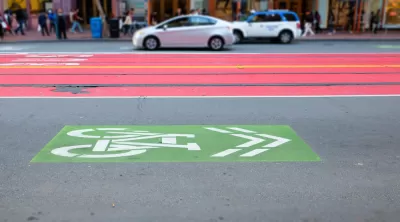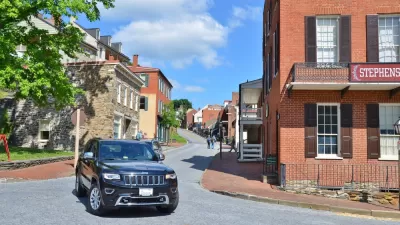Education, engineering, and enforcement are the three "e's" of Vision Zero in San Francisco. A lack of on of those "e's"—enforcement—might explain why more people are dying on the city's streets this year that any year since the city adopted Vision Z

San Francisco is five years into a ten-year Vision Zero goal, according to an article by Heather Knight, but traffic fatalities are rising on the city's streets. So far in 2019, "22 people have lost their lives on the city’s streets. That’s one less than died in all of 2018 and two more than died in all of 2017." That total includes 15 pedestrians. Another five people have died on freeways located in the city.
"[The city is] on pace to surpass the 31 deaths in 2014, the year Vision Zero began," adds Knight.
Looking for answers to the question of why San Francisco is backsliding on traffic safety, Knight identifies a lack of traffic enforcement as a likely culprit.
"New figures obtained by The Chronicle show the San Francisco Police Department is ticketing far fewer drivers for illegal behavior behind the wheel than it did the year Vision Zero was adopted," according to Knight. The neglect of traffic enforcement "could be explained by too many unfilled vacancies in the department’s traffic division and ever-changing leadership of the crucial unit."
The article includes more information about the lack of traffic safety enforcement, including data specific to the kinds of tickets written and in which neighborhoods.
FULL STORY: Deaths on SF’s streets are up. Traffic enforcement is down. ‘It’s hard to believe these aren’t related’

Alabama: Trump Terminates Settlements for Black Communities Harmed By Raw Sewage
Trump deemed the landmark civil rights agreement “illegal DEI and environmental justice policy.”

Planetizen Federal Action Tracker
A weekly monitor of how Trump’s orders and actions are impacting planners and planning in America.

The 120 Year Old Tiny Home Villages That Sheltered San Francisco’s Earthquake Refugees
More than a century ago, San Francisco mobilized to house thousands of residents displaced by the 1906 earthquake. Could their strategy offer a model for the present?

LA’s Tree Emergency Goes Beyond Vandalism
After a vandal destroyed dozens of downtown LA trees, Mayor Karen Bass vowed to replace them. Days later, she slashed the city’s tree budget.

Sacramento Leads Nation With Bus-Mounted Bike Lane Enforcement Cameras
The city is the first to use its bus-mounted traffic enforcement system to cite drivers who park or drive in bike lanes.

Seattle Voters Approve Social Housing Referendum
Voters approved a corporate tax to fund the city’s housing authority despite an opposition campaign funded by Amazon and Microsoft.
Urban Design for Planners 1: Software Tools
This six-course series explores essential urban design concepts using open source software and equips planners with the tools they need to participate fully in the urban design process.
Planning for Universal Design
Learn the tools for implementing Universal Design in planning regulations.
Ada County Highway District
Clanton & Associates, Inc.
Jessamine County Fiscal Court
Institute for Housing and Urban Development Studies (IHS)
City of Grandview
Harvard GSD Executive Education
Toledo-Lucas County Plan Commissions
Salt Lake City
NYU Wagner Graduate School of Public Service





























